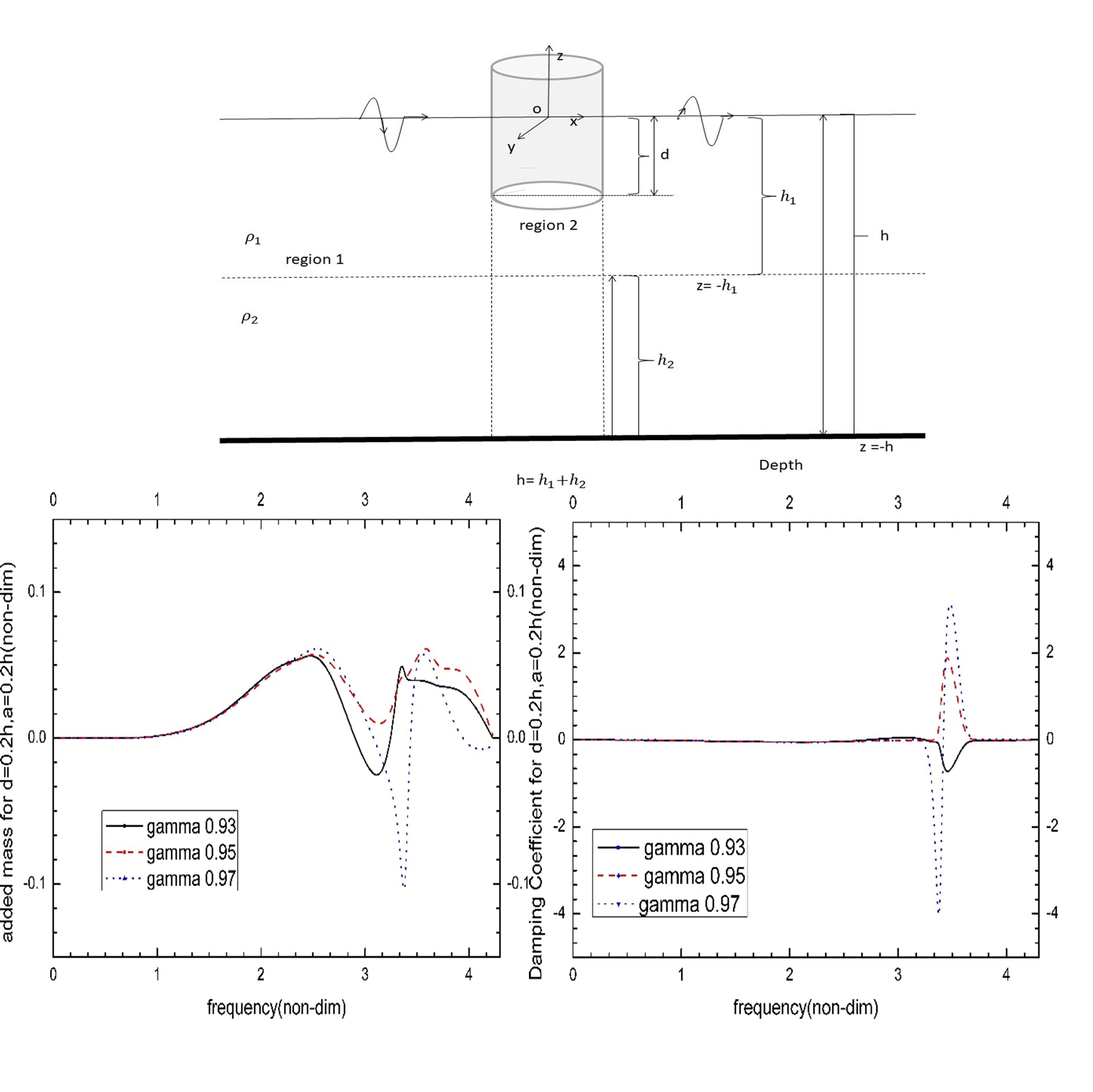Analysis of Hydrodynamic Loads by a Vertical Hollow Cylindrical Structure in A Two-Layer Fluid of Finite Depth
DOI:
https://doi.org/10.48048/tis.2024.7730Keywords:
Eigen function, Added mass, Damping coefficient, Two-layer fluid, Surge radiationAbstract
This paper aims to study the effect of surge radiation by a vertically hollow cylinder floating in a two-layer fluid of finite depth. Since most of the important characteristics of the oscillating water column are preserved by the hollow cylindrical structure, so the proposed device can be considered as an oscillating water column (OWC) which is one of the important wave energy device. In this two-layer fluid system, the upper layer is bounded above by a free surface and the lower layer is bounded below by a solid impermeable bottom, and the submerged hollow cylindrical structure allows it to oscillate in a surge mode of motion in the upper layer. On the assumption that wave amplitudes are small in comparison to wavelengths, hence the linear water wave theory is applied to formulate boundary value problems by dividing whole domain into 2 sub-domains. The formulated boundary value problems for surge radiated potentials in each sub-domain; we execute to obtain solutions in each sub-domain by using variable separation and matched eigenfunction expansion methods. With the help of obtained surge radiated potentials, we derive the radiation forces by the device in terms of added mass and damping coefficients. A set of influences of different parameters of the device on the added mass and damping coefficients are demonstrated in both surface and internal wave modes of motion. Hydrodynamic coefficients oscillate highly near a particular frequency, which leads to the resonance phenomena. In addition to that, the 3D plots of the free surface elevation in surface and internal wave modes are presented. A density ratio γ = 0.97 has a higher oscillation than a density ratio γ = 0.93, 0.95. High oscillations occur around a particular frequency ω = 3.83 due to the resonance phenomenon in which the waves incoming match with the natural motion of the object.
HIGHLIGHTS
- A floating hollow vertical cylindrical structure is considered in a two-layer fluid system having finite depth
- The separation of variables and matched eigenfunction expansion methods are utilized to obtain the solutions to the boundary-value problems
- The diffracted velocity potentials under the surge mode of motion are evaluated in the identified regions
- The added mass, damping coefficients, free surface and interface elevations in surface and internal wave modes are evaluated with different set of parameters of the device
- A number of results are presented regarding the effect of parameters of the device on the added mass, damping coefficients, free surface and interface elevations
- It is observed that the density ratio of the two-layer fluid has significant effect on the added mass, damping coefficient and the elevations
GRAPHICAL ABSTRACT

Downloads
Metrics
References
H Lamb. Hydrodyamics. Cambridge University Press, New York, 1994.
KK Barman, A Chanda and CC Tsai. A mathematical study of a two-layer fluid flow system in the presence of a floating breakwater in front of VLFS. Appl. Math. Model. 2023; 122, 706-30.
KK Barman and SN Bora. Scattering and trapping of water waves by a composite breakwater placed on an elevated bottom in a two-layer fluid flowing over a porous sea-bed. Appl. Ocean Res. 2021; 113, 102544.
K Trivedi and S Koley. Mathematical modeling of breakwater-integrated oscillating water column wave energy converter devices under irregular incident waves. Renew. Energ. 2021; 178, 403-19.
M Biswakarma, P Borah and M Hassan. Added mass and damping coefficients in sway motion for a floating hollow cylinder in a channel of finite width. Univ. Rev. 2019; 10, 201-11.
M Biswakarma, P Borah and M Hassan. Analytical solution of surge hydrodynamic coefficients by an-offshore structure model in a channel of finite width. J. Comput. Math. Sci. 2019; 10, 961-71.
M Hassan, SN Bora and M Biswakarma. Water wave interaction with a pair of floating and submerged coaxial cylinders in uniform water depth. Mar. Syst. Ocean Tech. 2020; 15, 188-98.
JN Newman. The damping of an oscillating ellipsoid near a free surface. J. Ship Res. 1961; 5, 1-19.
S Koley and K Trivedi. Mathematical modeling of oscillating water column wave energy converter devices over the undulated sea bed. Eng. Anal. Bound. Elem. 2020; 117, 26-40.
S Singla, H Behera and SC Martha. Scattering of Obliquely incident water waves by a surface piercing porous box. Ocean Eng. 2019; 193, 106577.
S Singla, H Behera, SC Martha and T Sahoo. Scattering of water waves by very large floating structure in the presence of a porous box. J. Offshore Mech. Arctic Eng. 2020; 144, 041904.
SA Selvan and H Behera. Wave energy dissipation by a floating circular flexible porous membrane in single and two-layer fluids. Ocean Eng. 2020; 206, 107374.
SA Selvan, R Gayathri, H Behera and MH Meylan. Surface wave scattering by multiple flexible fishing cage system. Phys. Fluid. 2021; 33, 037119.
IV Sturova. Radiation instability of a circular cylinder in a uniform flow of a two-layer fluid. J. Appl. Math. Mech. 1997; 61, 957-65.
IS Dolina. Amplification of the oscillatory motion of a body in a stratified fluid. Izv. Akad Nauk SSSR. MZhG, Russian, 1984.

Downloads
Published
How to Cite
Issue
Section
License
Copyright (c) 2023 Walailak University

This work is licensed under a Creative Commons Attribution-NonCommercial-NoDerivatives 4.0 International License.






